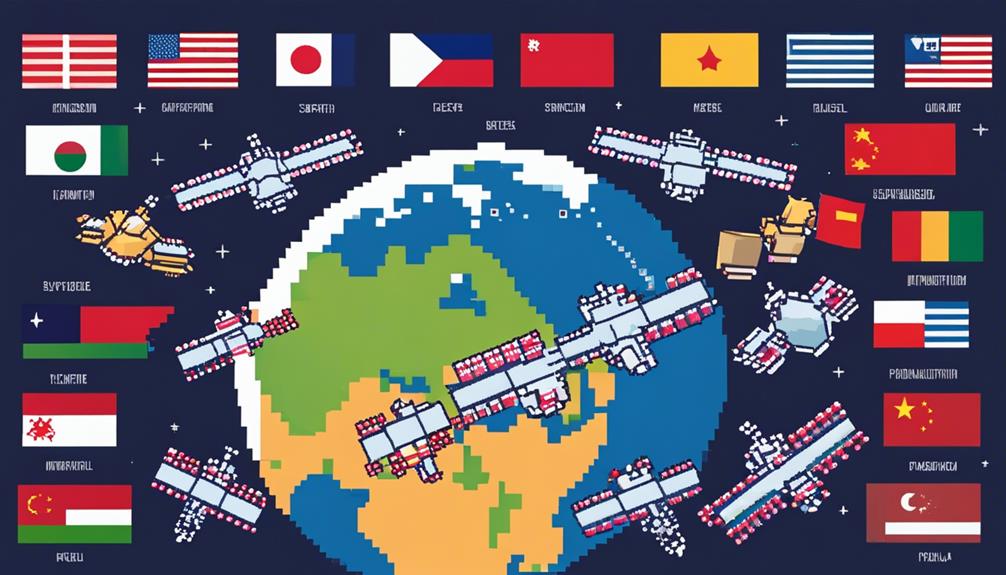In response to the emergence of Starlink, China has strategically embarked on the Hongyun and Hongyan projects, signaling a significant commitment to advancing satellite internet capabilities. These initiatives underscore China's ambition to carve out a competitive stance within the satellite communication sector. By exploring technical intricacies, comparative analyses, and potential market impacts, a deeper understanding of China's trajectory in this domain emerges. The implications of these developments on the global technological landscape are profound, hinting at a narrative worth exploring further.
Key Takeaways
- Integration of Hongyun and Hongyan projects into Guowang megaconstellation for global satellite coverage.
- Emphasis on LEO constellations to enhance connectivity and bridge digital divides.
- Development of satellite internet for national security and economic growth.
- China's strategic positioning in LEO space competition and market influence.
China's LEO Satellite Internet Initiatives

Amid China's technological advancements and strategic initiatives, the development of China's Low Earth Orbit (LEO) satellite internet infrastructure has been marked by the integration of the Hongyun and Hongyan projects into the Guowang megaconstellation in 2020. The Guowang constellation represents a significant leap forward in China's ambition to establish a competitive satellite internet network akin to Starlink. This integration underscores China's commitment to enhancing its LEO communications capabilities through the consolidation of resources and expertise from the Hongyun and Hongyan projects.
China's emphasis on LEO constellations as part of its national new infrastructure projects highlights the strategic importance attached to the Guowang constellation. Although specific details about the progress and development of the Guowang constellation remain limited, the alignment of commercial launch companies in China towards deploying LEO communications constellations indicates a concerted effort to bolster the country's satellite internet capabilities.
The merging of the Hongyun and Hongyan projects into the Guowang megaconstellation signifies a pivotal moment in China's pursuit of establishing a robust LEO satellite internet infrastructure. By leveraging the combined strengths of these projects, China aims to enhance its technological prowess in the realm of satellite communications and compete on a global scale with other established players in the industry.
Overview of Hongyun Project
In the realm of China's ambitious space endeavors, the Hongyun Project, spearheaded by the China Aerospace Science and Industry Corporation (CASIC), emerges as a crucial initiative aimed at establishing global satellite internet coverage. This project is part of China's strategic move to develop its satellite internet system, akin to initiatives like Starlink, to enhance its technological competitiveness.
- The Hongyun Project plans to deploy a constellation of more than 800 Low Earth Orbit (LEO) satellites. These satellites will operate closer to Earth, enabling faster transmission of internet signals and reducing latency for users.
- CASIC intends for the Hongyun satellites to provide high-speed internet services worldwide. By employing LEO satellites, the project aims to ensure comprehensive global coverage, even in remote or underserved regions.
- With the Hongyun Project, China aims to bolster its space capabilities significantly. By leveraging a network of LEO satellites, the project seeks to offer reliable and accessible internet services on a global scale, contributing to China's presence in the satellite internet sector.
Overview of Hongyan Project

The Hongyan project by China aims to expand satellite coverage globally, providing internet connectivity to even the most remote areas. With thousands of LEO satellites, the project strives to offer broadband communication services, led by China Aerospace Science and Industry Corporation (CASIC). These satellites are specifically designed to enhance internet accessibility in rural and underserved regions.
Satellite Coverage Expansion
Deploying a constellation of LEO satellites, the Hongyan project aims to establish comprehensive global satellite coverage to facilitate communication services. The project involves the deployment of a network of satellites orbiting closer to Earth to ensure efficient broadband internet access. Key features of the Hongyan satellite coverage expansion include:
- Global Reach: Providing connectivity worldwide, especially in remote and underserved areas.
- High-Speed Internet: Offering fast and reliable internet access with low latency for seamless communication.
- Diverse Applications: Supporting a wide range of applications such as telecommunication, emergency response, and IoT services.
Through the Hongyan project, China aims to bolster its satellite coverage capabilities and enhance global connectivity similar to initiatives like Starlink.
Connectivity for Remote Areas
Facilitating connectivity in remote regions, the Hongyan project endeavors to establish a LEO broadband satellite constellation to deliver high-speed internet access. Through the deployment of LEO broadband satellites, this initiative aims to address the connectivity challenges faced by remote areas in China. The network of satellites will enable the provision of broadband services, including internet access, video conferencing, and multimedia content delivery, enhancing communication infrastructure in underserved regions. By focusing on bridging the digital divide, the Hongyan project aligns with China's goal of improving access to essential services such as telemedicine, distance learning, and e-commerce for remote communities. This strategic approach underscores the project's commitment to leveraging satellite technology to enhance connectivity and foster development in remote areas.
Comparison With Starlink
In comparison to Starlink, the Hongyun and Hongyan projects represent China's strategic endeavor to establish a competitive foothold in the global satellite internet market. These projects aim to provide global satellite internet coverage and high-speed broadband services through the deployment of Low Earth Orbit (LEO) satellites. To differentiate the Hongyun and Hongyan projects from Starlink, consider the following key points:
- Satellite Internet Coverage: Hongyun and Hongyan projects, similar to Starlink, aim to provide global coverage for satellite internet services. However, each project may focus on specific regions or markets to optimize their services.
- LEO Satellites Deployment: Both Starlink and the Hongyun/Hongyan projects utilize LEO satellites to deliver internet services. The use of LEO satellites enables lower latency and faster data transmission compared to traditional geostationary satellites.
- Broadband Services: Hongyun and Hongyan projects emphasize offering high-speed broadband services to users worldwide. The focus is on bridging the digital divide and providing reliable internet connectivity in remote or underserved areas, aligning with the global trend towards universal connectivity.
Technical Capabilities and Innovations

The technical advancements driving the capabilities and innovations of the Hongyun and Hongyan projects in the realm of global satellite internet services position China as a formidable contender in the competitive landscape of satellite communications. These projects involve the deployment of satellite constellations consisting of Low Earth Orbit (LEO) satellites to enable the provision of high-speed internet services on a global scale. Hongyun specifically targets providing broadband services to remote areas and maritime users, while Hongyan aims to achieve comprehensive global coverage.
The satellites utilized in the Hongyun and Hongyan projects leverage cutting-edge technologies to ensure the efficient and reliable delivery of internet connectivity. By operating in LEO, these satellites can reduce latency and offer improved performance compared to traditional geostationary satellites. Additionally, the use of satellite constellations allows for better coverage and network redundancy, enhancing the overall reliability of the internet services provided.
Through these technological innovations, China is strategically positioning itself to compete with other global initiatives such as Starlink. By focusing on global broadband internet services and leveraging the capabilities of LEO satellites, the Hongyun and Hongyan projects showcase China's commitment to advancing its capabilities in satellite communications to meet the growing demand for high-speed connectivity on a global scale.
Strategic Implications for China
Strategically positioning itself as a key player in the global satellite communications arena, China's Hongyun and Hongyan projects hold profound implications for the nation's technological autonomy and strategic interests in the space industry. These initiatives mark a pivotal moment for China's space ambitions, with implications spanning national security, digital sovereignty, and technological advancement:
- Satellite Internet Constellation: The development of the Hongyun and Hongyan projects signifies China's pursuit of a satellite internet constellation to rival existing systems like Starlink. By establishing its own network, China aims to ensure reliable and secure internet connectivity across vast geographical areas, reducing reliance on foreign providers and enhancing its strategic autonomy.
- National Security: Building indigenous satellite communication capabilities through Hongyun and Hongyan projects enhances China's national security posture. By controlling its satellite infrastructure, China can safeguard critical communication channels, mitigate vulnerabilities to potential cyber threats, and maintain secure data transmission, crucial for both civilian and military applications.
- Digital Sovereignty: The projects represent a strategic move towards digital sovereignty, enabling China to assert greater control over its cyberspace and information flow. By owning and operating a satellite internet constellation, China can regulate data transmission, protect user privacy, and uphold its regulatory authority in the digital domain, reinforcing its position as a global technological powerhouse.
Global Competition in LEO Space

Amidst the intensifying competition in the Low Earth Orbit (LEO) space communications market, China's Hongyun and Hongyan projects emerge as strategic endeavors to establish a formidable presence and drive innovation in satellite internet constellations. These projects represent China's response to the increasing global competition in LEO space communications, particularly with initiatives like Starlink gaining momentum. By focusing on developing their own satellite internet constellations, China aims to position itself as a key player in the satellite communications sector.
The global competition in LEO space is pushing countries and companies to invest heavily in advancing satellite internet constellations like Hongyun and Hongyan. With the demand for high-speed internet connectivity growing rapidly worldwide, the race to deploy efficient and reliable satellite networks has become more intense. China's Hongyun and Hongyan projects are integral parts of the nation's broader strategy to compete in this evolving market landscape.
As nations vie for dominance in LEO space communications, the competition is not just about technological prowess but also about strategic positioning and economic influence. Innovations in satellite internet constellations driven by this global competition are expected to reshape the way people connect and communicate across the globe. China's active participation in this competitive environment signifies its commitment to leveraging space technology for both commercial and strategic purposes.
Military Applications and Concerns
In light of the escalating competition in the Low Earth Orbit (LEO) space communications market and the strategic significance of satellite networks for military applications, the focus shifts towards examining the military implications and concerns surrounding the utilization of innovative constellations like Starlink.
Military Applications and Concerns:
- Satellite Technology Advancements: The utilization of advanced satellite technology, such as Starlink, for military applications enables functions like intelligence reconnaissance, missile warning systems, and maintaining communication stability during conflicts.
- Chinese LEO Strategies: China's initiatives, like the Hongyun and Hongyan Projects, showcase the country's efforts to bolster its own LEO capabilities for military purposes, including potential interception of satellites like Starlink.
- Countermeasures and Challenges: Conventional and advanced jamming techniques are being developed to counter the military significance of satellite networks like Starlink. However, direct attacks on these satellites are deemed economically impractical, leading to a focus on alternative disruptive strategies.
The evolving landscape of satellite technology and its integration into military operations highlight the need for robust strategies to harness the benefits while mitigating potential risks and challenges posed by adversaries.
Economic and Commercial Potential

The economic and commercial potential of the Hongyun and Hongyan projects lies in capturing market opportunities by providing global internet coverage, potentially influencing trade dynamics through enhanced connectivity, and fostering growth through the expansion of satellite-based services. These projects have the capacity to offer high-speed internet services to areas that currently lack adequate connectivity, potentially transforming industries and enabling new economic opportunities for China on a global scale. By investing in these projects, China positions itself to strengthen its foothold in the satellite communications market, potentially shaping the future of internet connectivity and digital services.
Market Opportunities for Hongyun
With the aim of revolutionizing global broadband internet coverage, the Hongyun project presents significant market opportunities for various industries reliant on seamless connectivity. The economic potential of Hongyun is vast, especially in providing affordable and accessible internet services to underserved regions, ultimately driving digitalization and economic growth. Additionally, the commercial potential of Hongyun includes forming partnerships with telecommunications companies to expand networks and offer services. The market opportunities for Hongyun extend to sectors such as maritime, aviation, agriculture, and disaster response, enhancing operational efficiency and safety. This project's economic and commercial benefits position China competitively in the global satellite internet market, fostering innovation and collaboration.
- Enhanced connectivity for underserved regions
- Integration into various industries for operational efficiency
- Competitive advantage in the global satellite internet market
Trade Impact of Hongyan
Expanding on the extensive economic and commercial implications highlighted by the Hongyun project, the trade impact of Hongyan is poised to significantly alter international commerce dynamics through enhanced global internet coverage. The provision of global internet coverage by the Hongyan project can revolutionize e-commerce activities by improving connectivity and accessibility for businesses worldwide. This enhancement is anticipated to promote cross-border trade and economic growth by facilitating smoother transactions and collaborations. Moreover, Hongyan's satellite network can play a crucial role in supporting communication services for businesses, enabling more efficient operations and interactions across borders. The improved internet connectivity offered by Hongyan can particularly benefit industries like logistics and supply chain management, enhancing trade efficiency through real-time data exchange and faster decision-making processes.
Growth Potential for Projects
Demonstrating immense economic and commercial promise, the growth potential of the Hongyun and Hongyan projects lies in their capacity to revolutionize global broadband coverage.
- Satellite Manufacturing: The projects can spur advancements in satellite manufacturing technology, leading to cost-effective production and deployment of satellites for enhanced connectivity.
- Economic Impact: Job creation in satellite manufacturing and telecommunications sectors can stimulate economic growth, offering employment opportunities and driving innovation in related industries.
- Commercial Partnerships: Collaborations stemming from these projects can result in strategic commercial partnerships, expanding market reach and solidifying China's position as a key player in the satellite internet market.
International Collaboration Opportunities

China's efforts in the space sector have paved the way for fruitful international collaboration opportunities with various countries, including Belarus, Pakistan, Egypt, and Brazil. Collaborations with Belarus and Pakistan have already been established, demonstrating China's commitment to fostering global partnerships in space exploration. The potential for future collaborations with Egypt and Brazil indicates a broadening of China's international partnerships in the space domain.
The international collaboration opportunities in the space sector are expanding, with China actively seeking engagement with a wider range of countries for mutual benefit. This strategic approach aligns with China's goal of fostering global partnerships for space exploration and satellite technology development. The Hongyun and Hongyan projects specifically present avenues for international cooperation, showcasing China's willingness to collaborate with other nations in advancing satellite internet infrastructure.
| Country | Ongoing Collaborations | Potential Collaborations |
|---|---|---|
| Belarus | Space sector cooperation | – |
| Pakistan | Joint satellite projects | – |
| Egypt | – | Future space exploration ties |
| Brazil | – | Prospective partnership |
Regulatory Challenges and Considerations
The regulatory landscape surrounding China's Hongyun and Hongyan projects presents intricate challenges related to spectrum allocation, licensing requirements, and government agency coordination, critical factors that must be navigated for the successful deployment and operation of the satellite internet constellations.
- Spectrum Allocation: Securing the necessary frequency bands for satellite communication is a complex process that involves coordination with international regulatory bodies and ensuring interference-free operations.
- Compliance with International Regulations: Adhering to international standards and regulations is paramount for the global acceptance and interoperability of China's satellite internet projects.
- Government Agency Coordination: Collaboration and alignment with various governmental bodies are essential to address national security concerns, ensure regulatory compliance, and streamline the approval processes for the deployment of satellite constellations.
Managing regulatory challenges such as spectrum allocation, compliance with international regulations, and coordination with government agencies requires a deep understanding of the intricate frameworks governing satellite communications. Balancing the need for innovation and market competitiveness with regulatory requirements is a delicate task that China's Hongyun and Hongyan projects must navigate to establish themselves as significant players in the satellite internet industry.
Environmental Impact Assessment

An essential aspect of the satellite internet projects' development involves conducting a comprehensive assessment of their environmental impact. The environmental impact assessment for China's Hongyun and Hongyan projects encompasses evaluating the effects on ecosystems, air quality, and water resources. This assessment aims to ensure compliance with regulations, mitigate negative environmental effects, and promote responsible space development. Factors such as carbon footprint, energy consumption, and waste management related to the satellite deployment are carefully evaluated to minimize adverse impacts. Evaluations also consider the potential effects on biodiversity, habitats, and wildlife in the areas where the satellite constellations will operate. Additionally, the long-term impacts on climate change, pollution levels, and sustainability practices are taken into account to establish environmentally conscious practices.
| Environmental Impact Assessment | Evaluation Areas | Objectives |
|---|---|---|
| Ecosystems | Biodiversity, habitats | Minimize impact on wildlife and natural habitats |
| Air Quality | Pollution levels | Reduce emissions and maintain air quality standards |
| Water Resources | Usage and contamination | Ensure responsible water resource management |
This meticulous evaluation of the environmental impact is crucial in safeguarding ecosystems, preserving biodiversity, and ensuring sustainable practices in the deployment and operation of satellite constellations.
Future Expansion Plans
What strategies are being implemented to expand the coverage and connectivity capabilities of the Hongyun and Hongyan projects through increased satellite deployment into low Earth orbit? China's future expansion plans for the Hongyun and Hongyan projects involve a series of strategic initiatives to enhance global internet coverage and connectivity. These initiatives include:
- Increasing Satellite Constellations: China plans to expand its satellite constellations by deploying more satellites into low Earth orbit. By increasing the number of satellites orbiting closer to Earth, the coverage and connectivity capabilities of the Hongyun and Hongyan projects will be significantly improved.
- Enhancing Global Internet Coverage: The focus of the expansion plans is to provide high-speed broadband services to users worldwide. By integrating advanced satellite technologies, China aims to ensure seamless internet access across the globe, bridging the digital divide and enhancing connectivity on a global scale.
- Creating a Robust Network: By deploying additional satellites into low Earth orbit, China seeks to establish a robust network that can support the growing demand for internet services. This network will form the foundation for the Hongyun and Hongyan projects, enabling them to deliver reliable and high-quality internet connectivity to a diverse range of users.
User Adoption and Market Penetration

To facilitate the widespread acceptance and utilization of the Hongyun and Hongyan projects, strategic user adoption and market penetration initiatives are being implemented to enhance connectivity and bridge the digital divide. Leveraging LEO satellite technology, these projects aim to provide high-speed internet services to rural and underserved areas. User adoption strategies focus on offering affordable pricing plans and tailored services to attract a diverse customer base, while market penetration efforts involve expanding coverage, enhancing network reliability, and improving the overall user experience for widespread acceptance.
| User Adoption Strategies | Market Penetration Efforts |
|---|---|
| – Affordable pricing plans | – Expanding coverage |
| – Tailored services | – Enhancing network reliability |
| – Diverse customer base targeting | – Improving user experience |
Conclusion and Key Takeaways
The key takeaways from the Hongyun and Hongyan projects revolve around the need for a comprehensive project progress update to gauge the current status and trajectory. An in-depth potential impact assessment is essential to understand the implications of these projects on the global satellite communication landscape. Looking ahead, an analysis of the future development prospects will shed light on the competitiveness and sustainability of China's satellite constellation endeavors.
Project Progress Update
Limited information has been disclosed regarding the current progress of the Guowang megaconstellation, encompassing the consolidated Hongyun and Hongyan projects in China.
- Satellites Launched:
- Specific details on the number of satellites launched remain undisclosed.
- LEO Communications Constellations:
- The focus of the project is to establish a Low Earth Orbit (LEO) communications constellation.
- Commercial Space Firms:
- Emerging commercial space firms in China are actively involved in preparing for the deployment of the Guowang megaconstellation.
These developments highlight the strategic importance of the Guowang project in China's efforts to establish its own LEO communications network, with a significant emphasis on collaboration with commercial entities to drive innovation and progress in the space sector.
Potential Impact Assessment
Assessing the potential impact of China's Hongyun and Hongyan projects on the global satellite internet market reveals strategic implications for the industry's future landscape. These LEO communications constellations could disrupt the current market dynamics dominated by players like Starlink. Below is a comparison table highlighting key aspects of the Hongyun and Hongyan projects:
| Aspect | Hongyun Project |
|---|---|
| Orbit | Low Earth Orbit (LEO) |
| Coverage | Global |
| Goal | Provide global internet coverage |
| Competitors | Starlink, OneWeb |
| Strategic Implications | Competing with established players |
The success of these projects could reshape the satellite internet sector, positioning China as a significant player in satellite communications.
Future Development Prospects
Positioning China as a formidable contender in the global satellite internet market, the consolidation of the Hongyun and Hongyan projects under the Guowang megaconstellation signifies a strategic move towards challenging established players and advancing the nation's satellite communication capabilities. The future development prospects for China's satellite internet initiatives are promising, with a focus on establishing a comprehensive LEO communications constellation to rival Starlink within the next five years. Private enterprises like Galaxy Space and state-owned companies are actively contributing to the advancement of China's satellite internet capabilities. Collaboration between government entities, private companies, and international partners will be crucial for the successful development of China's satellite internet projects.
- Establishment of a comprehensive LEO communications constellation
- Active involvement of private enterprises and state-owned companies
- Strategic positioning of the Chinese space industry to compete globally
Frequently Asked Questions
How Is China Responding to Starlink?
In the midst of the space race and heightened global competition, China is strategically leveraging satellite technology to counter emerging contenders. Focused on bolstering its position in the satellite communications arena, China is making significant strides in developing innovative projects to respond to the challenges posed by competitors. Through meticulous planning and execution, China is poised to make a substantial impact in the realm of satellite technology amidst the evolving landscape of global connectivity.
What Is China's Equivalent to Spacex?
In the space race, China's equivalent to SpaceX is represented by its ambitious projects, such as the Hongyun and Hongyan initiatives. These endeavors symbolize China's pursuit of technological advancements in satellite communication, positioning the country as a key player in the global competition for dominance in the satellite internet market. Through the development of its own constellations, China aims to ensure sovereignty and independence while showcasing its commitment to advancing space capabilities on par with industry leaders.
Can China Block Starlink?
China's strategy to potentially block Starlink involves utilizing its technological capabilities in space. This approach could pose obstacles to Starlink's operations in certain regions. The global implications of China's actions could lead to increased competition in the satellite internet market. This scenario highlights the ongoing space race for dominance in satellite internet services, with countries like China actively working to establish their own satellite internet systems to counter the influence of existing providers like Starlink.
Why Is China Launching so Many Satellites?
China is launching a significant number of satellites to bolster its satellite communication capabilities. This surge in satellite deployments is driven by the government's substantial investment in advancing technological prowess to compete globally. The aggressive satellite launch campaign reflects China's commitment to enhancing connectivity worldwide through cutting-edge satellite technology. The strategic move underscores China's ambition to establish a robust network for high-speed internet services and secure a competitive edge in the global space race.

